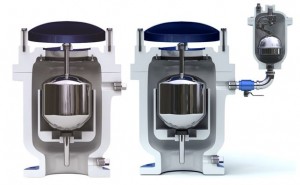APCO Air/Vacuum Valves & Combination Air Valves (AVV)
Design Features:
What Are Air/Vacuum Valves?
APCO Air/Vacuum Valves are float operated and have a large discharge orifice equal in size to the valve’s inlet. Air/Vacuum valves allow large volumes of air to be exhausted from or admitted into a pipeline as it is being filled or drained. As the pipeline fills, fluid enters the valve, raises the float and shuts-off. When draining the pipeline, the float drops and allows air to enter, preventing a vacuum and possible pipeline collapse or damaging water column separation.
The AVV can also be configured as a Dual Body Combination Air Valve with an ARV Air Release Valve. The AVV Dual Body Combination Air Valve combines the functions of both an Air/Vacuum Valve to expel large volumes of air during filling or draining of the pipeline, along with an Air Release Valve to release small quantities of air during normal operation. Combination Air Valves are typically installed on all high points of a system where it has been determined that the functions of both an Air/Vacuum Valve and an Air Release Valve are needed to vent and protect a pipeline.
How Do Air/Vacuum Valves Work?
The function of an Air/Vacuum Valve is to protect a pipeline from damage. Air/Vacuum Valves expel large quantities of air when filling the pipeline, and admit large quantities of air to relieve a vacuum when draining the pipeline. APCO AVV Air/Vacuum Valves are float operated and have a large discharge orifice, equal in size to the valve inlet, for efficient filling and draining of pipelines.
When filling a pipeline, the Air/Vacuum Valve is open. Once the pipeline is filled, the Air/Vacuum Valve closes and remains closed during normal operation. When the pipeline is drained, the pressure returns to atmospheric and the Air/Vacuum Valve will immediately open to allow air to re-enter the pipeline to prevent a vacuum from developing. In this way, the large venting orifice protects against vacuum and water column separation or pipeline collapse.
Design & Construction of Air/Vacuum Valves
The Air/Vacuum Valve consists of a body, cover, baffle, seat and stainless steel float. The baffle is designed to protect the float from direct contact with rushing air or slugs of water which prevents premature shutoff. The resilient seat is fastened to the valve cover and can be easily removed if needed. The 316 stainless steel float is center guided at each end for positive seating.
The following body styles are available:
• AVV Air/Vacuum Valve Body Style 140
The APCO Air/Vacuum Valves in Body Style 140, in sizes .5-3” (15-80mm), are available in ductile iron bodies with a threaded NPT inlet and outlet as standard. ASME 125/150 or 250/300 flanged outlets are available as an option.
• AVV Air/Vacuum Valve Body Style 140H
The APCO Air/Vacuum Valves in Body Style 140H are designed for higher pressure service and are available in sizes 1-3” (25-80mm).
• AVV Air/Vacuum Valve Body Style 150
The APCO Air/Vacuum Valves in Body Style 150, in sizes 4-18” (100-450mm), with ASME 125/150 or 250/300 flanged inlets and a plain outlet with steel protector hood as standard. Threaded or flanged outlets are available for valves used inside a pump house.
Dual Body Combination Air Valves
APCO AVV Dual Body Combination Air Valves combine an Air/Vacuum Valve with an Air Release Valve. Combination Air Valves, also called double orifice valves, are typically installed on all high points of a system where it has been determined that the functions of both an Air/Vacuum Valve and an Air Release Valve are needed to vent and protect a pipeline.
The Dual Body Combination Air Valve body styles 1800/1800K include an Air/Vacuum Valve piped with a shutoff valve to an Air Release Valve. The Air/Vacuum Valve expels large quantities of air when filling and admits air to relieve vacuum when draining.
The Air Release Valve prevents small air pockets from accumulating at the high points of the pipeline that can restrict flow. The Air Release Valve operates under pressure to release entrapped air in the pipeline. The Air Release Valve stays normally closed to prevent the pipeline fluid from escaping. When enough air accumulates to form a pocket, the float lowers and opens the valve orifice to release air. The air release valve then closes until more air accumulates and the opening cycle repeats automatically. By relieving air pockets that restrict flow, a Combination Air Valve can quickly pay for itself in minimizing head loss, which results in reduced energy costs.
The dual body style allows use of a wide variety of Air Release Valves with a range of orifices and higher operating pressures. DeZURIK also offers two styles of APCO Single Body Combination Air Valves - the APCO AVC Single Body Combination Air Valves or ASU High Performance Single Body Combination Air Valve. Single body styles are used where compactness is preferred, and/or where risk of tampering exists due to accessibility of the installation. Refer to separate product bulletins for details.
Refer to APCO Air Valve Selection & Sizing Guide, Bulletin 610, for Air Release Valve sizing data and formulas.
Air/Vacuum Valves & Combination Air Valves (AVV) Specifications
SIZE RANGE:
1/2-18" (15-450mm)
BODY STYLES:
Air/Vacuum Body Styles 140, 140H and 150
Combination Valve Body Styles 1800, 1800K
BODY MATERIAL:
Ductile iron, cast iron, carbon steel, 316 stainless steel
CAD Files
Bulletins (English)
- APCO AVV Air/Vacuum Valves and Dual Body Combination Air Valves 601
- APCO Air Valves for Vertical Turbine Pumps, Double Acting Throttling Device 586





